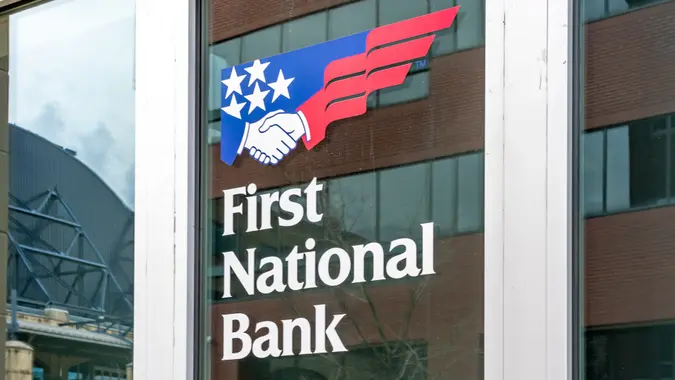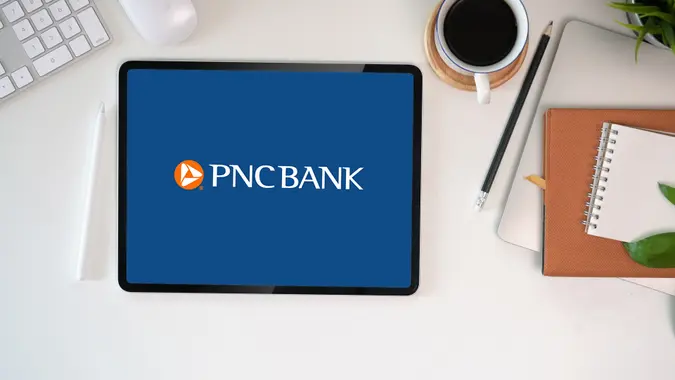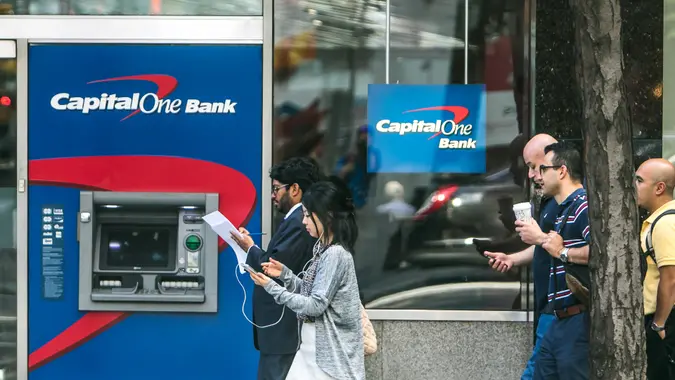Capital One Login: How To Access Your Account Securely

Commitment to Our Readers
GOBankingRates' editorial team is committed to bringing you unbiased reviews and information. We use data-driven methodologies to evaluate financial products and services - our reviews and ratings are not influenced by advertisers. You can read more about our editorial guidelines and our products and services review methodology.

20 Years
Helping You Live Richer

Reviewed
by Experts

Trusted by
Millions of Readers
If you’ve recently opened a Capital One account, you may be wondering: How do I log in to my Capital One account online?
The good news is that it’s simple to log in to your Capital One account from a computer, smartphone or tablet. Read on to learn how to log in, retrieve your password if you forget it and contact Capital One support if you get stuck.
How To Log In to Your Capital One Account
Once you set up your login details, you can sign in to your account to manage it online. The first option for doing so is on your computer.
Log In on a Computer
Follow these steps to sign in on a computer:
- Load the Capital One homepage.
- Enter your username and password in the spaces provided.
- Click “Sign In.”
If you’re not interested in typing in your username whenever you want to access your account online, click the “Remember Me” check box under your username. This will auto-fill your username when you load the Capital One homepage.
Log In to Your Capital One App
You can follow the steps above if you’re using a mobile browser, but the best way to bank on the go with Capital One is to use the company’s mobile app. Here are the steps to do so:
- Download the Capital One mobile app from the App Store or Google Play.
- When you load the app, it will prompt you to log in. Type your username and password into the fields provided.
- Tap the “Sign In” button.
If your device offers fingerprint or facial recognition, you can add these as methods to log in to your Capital One mobile app. All you need to do is opt into the service.
How To Reset Your Capital One Login Credentials
You can reset your credentials by either changing your password or recovering your username.
Resetting Your Password
Resetting your password isn’t hard to do on the website or in the app. Here are the steps:
- Step 1. Go to the Capital One login page.
- Step 2. Click “Forgot Password?” under the login fields.
- Step 3. Enter your username and last name, then click “Find Me.”
- Step 4. Select a verification method — text, email or phone call.
- Step 5. Enter the one-time code sent to your device.
- Step. 6. Create a new strong password and confirm the change.
Good To Know
Capital One may ask you to verify your identity. You may be required to confirm your identity via text, email or security questions. You may be asked to enter a one-time password and then update your password if there are security issues.
Recovering Your Username
If you want to recover your username:
- Step 1. Go to the Capital One login page.
- Step 2. Click “Forgot Username?” under the login fields.
- Step 3. Enter your last name, Social Security number or Tax ID, and date of birth.
- Step 4. Click “Find Me,” and your username will be displayed.
Contacting Capital One Support for Assistance
If you need help during this process, you can call Capital One. For general assistance, call 1-877-383-4802. For mobile banking support, call 1-800-655-2265.
Capital One Mobile App Login Guide
If you’re someone who likes to have your account access handy, you can download the Capital One app.
How To Download and Set Up the App
You can follow these steps to set up your Capital One app:
- Download the Capital One app via the App Store or Google Play.
- Open the app and sign in, or enroll if you are a new user.
- Enter your username and password.
- Complete the security verification and enable two-factor authentication.
Features Available Through Mobile Banking
Through your mobile app, you can check your balances and transfer funds. You can view your transaction history and deposit checks. You can also pay bills through your account via your mobile app.
Using Biometric Login
You can access your app and go to the settings. Navigate to “Security” and log in. Once there, you can enable Face ID or Fingerprint login. Follow the prompts to scan your face or fingerprint.
Troubleshooting Capital One Login Issues
Sometimes you may encounter issues trying to log in to your account. Here are some common issues and how to unlock temporarily locked accounts.
Common Login Errors and Solutions
If you frequently use the website or your app to access your account, you may run into login errors.
- Incorrect username or password. Check the spelling of your username and password. Also, make sure your caps lock key is on or off depending on your password. Click “Forget Username or Password” to reset credentials.
- Too many failed attempts. If you try to log in but fail too many times, the system will automatically lock you out. Wait for 15 minutes before you try to log in again or reset your password.
- Outdated credentials. If you’re using a saved password, it may be the wrong credentials. Clear saved passwords.
Browser and Device Compatibility Issues
Sometimes you cannot log in because of browser and device issues. You may need to clear your cache or cookies.
- In Chrome, you need to do the following:
- Navigate to settings.
- Click on “Privacy & Security.”
- Choose “Clear Browsing Data.”
- If you’re in Safari, follow these steps:
- Click on “Preferences.”
- Choose “Privacy.”
- Once you are in the privacy setting, navigate to “Manage Website Data.”
- Select “Remove All.”
You can also try using a different device or browser to see if this clears your account issues. Another option is to disable browser extensions.
How To Unlock a Temporarily Locked Account
You can do three things to unlock a temporarily locked account because of security issues.
- Wait. Wait at least 15 to 30 minutes to log in again.
- Reset your password. Click “Forget Your Password” and follow the steps to reset.
- Call customer service. If your account remains locked, call customer service at 1-877-383-4802 for help.
Logging in From a New Device or Location
If you’re logging in through a new device or accessing your account from an unfamiliar location, you may need to take extra steps to log in to your account.
Here are common security verification steps:
- Email verification. Some banks may send you an email verification to make certain you are the one trying to access the account.
- Answer security questions. To verify your identity, you may need to answer a few security questions before logging in to your account.
- Two-factor authentication request. You may receive a one-time code through email, text or an authenticator app.
What To Do if You Receive a Suspicious Login Alert
If you receive a suspicious alert, review it carefully. Check for the transaction amount, the date and the location. Sometimes these are authorized transactions you conducted, but may seem suspicious to the bank, which therefore requests a second verification. Follow the prompt and verify that you authorized the transaction.
If it isn’t you, then you must do the following:
- Act promptly.
- Change your password.
- Enable 2FA, if you haven’t already.
- Contact your bank’s fraud department.
Updating Trusted Devices in Your Account Settings
If you don’t want an alert every time you log in to this new device, you can make the changes in your settings.
Simply log in to your account and access your settings, then “Security,” and navigate to “Trusted Devices.” Add and manage the devices that you are using. Save your changes.
Enabling Two-Factor Authentication for Added Security
Two-factor authentication adds another security layer to your account. 2FA requires not only your password when you log in, but also asks for a unique verification code that is sent to your device.
How To Set Up 2FA on Your Capital One Account
It doesn’t require much to set up 2FA on your account. Here are the steps to enable 2FA on the website and app:
- Step 1. Log in to your Capital One account.
- Step 2. Go to settings and navigate to security and log in.
- Step 3. Find the “Two-Factor Authentication” or “Multi-Factor Authentication” option.
- Step 4. Choose the way you would like to receive your code — text, authentication app or phone number.
- Step 5. Verify your identity and enable 2FA.
Benefits of Extra Security Measures
2FA is easy to set up, but the benefits are priceless. It protects you from hackers and scammers. They won’t be able to access your account because you’ve set up a required second way to be able to view your information. In addition, 2FA prevents fraud and identity theft.
You will also learn in real time if someone is trying to gain unauthorized access to your account. Knowing this information, you can act quickly by changing your passwords. You can also contact customer service to make certain there are no unauthorized transactions.
How To Update Your Security Preferences
If for some reason you need to update your preferences, you should log in in again. Follow the prompts to manage two-factor authentication. Select the update you want to make and save your changes.
How To Safely Log In to Your Capital One Account
One way to safely protect your account is to take certain preventive measures before a breach occurs. Here are a few ways to protect your account:
Recognizing Phishing Scams and Fake Websites
Phishing scams are popular. You will likely receive an email or text requesting your login details. Capital One will never send this kind of text or email.
Sometimes a fake website will look similar to Capital One, but there will likely be misspellings in the URL. Any text that asks you to act urgently and prompts you to click on a link is a scam to get your credentials.
Best Practices for Secure Online Banking
An easy way to protect your account is to use best practices when setting up and accessing your financial information.
- Always use passwords that have eight to 12 characters that include capital letters, numbers and symbols.
- Enabling 2FA also helps provide an extra layer of security to your account.
- Always log out after every session.
- Do not save passwords on your browser.
Using a Secure Network for Banking Transactions
You may be tempted to log in to your account at the airport or the grocery store. However, these networks are public and can lead to scammers getting your information. You should always use a secure, private Wi-Fi network or a VPN if accessing your account from a public connection.
FAQ
Here are answers to some commonly asked questions about accessing Capital One accounts.- Why can't I log in to my Capital One account?
- If you're unable to log in to your account, you may have the incorrect username or password. You may also have browser issues.
- Clear your cache and try to log in again. Be aware that multiple failed attempts to log in can lock you out of your account.
- How do I enable fingerprint or Face ID login?
- To enable these features, you can follow the following steps:
- Access your Capital One app.
- Go to "Settings."
- Navigate to "Security & Privacy."
- You can enable face ID or fingerprint requirements from this section.
- To enable these features, you can follow the following steps:
- Can I log in to multiple Capital One accounts from one device?
- Yes, but you'll need to log out and switch accounts manually in the app or use different browsers for online banking.
- What should I do if I suspect unauthorized access?
- You should immediately do the following:
- Change your password.
- Enable 2FA verification.
- Check your transactions.
- Call customer service if necessary to alert them of the breach.
- You should immediately do the following:
More About Capital One
- Capital One Review
- Capital One CD Rates
- Capital One Savings Account Interest Rates
- Capital One Hours
- Capital One Closest Branches and ATMs
Joshua Rodriguez contributed to the reporting for this article.
Information is accurate as of March 3, 2025.
Editorial Note: This content is not provided by any entity covered in this article. Any opinions, analyses, reviews, ratings or recommendations expressed in this article are those of the author alone and have not been reviewed, approved or otherwise endorsed by any entity named in this article.
 Written by
Written by  Edited by
Edited by 

























